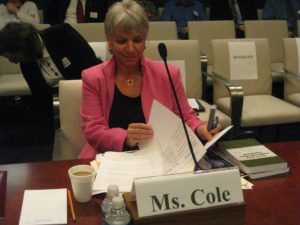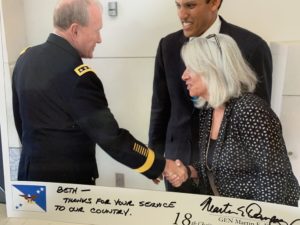“These people just keep going to the next disaster or the next war, but they’re not getting the help they need. That’s why I became an SEP—to bring help to this group of people.”
Beth Cole, SEP, has been doing conflict zone and disaster response work since the Berlin Wall fell in 1989. She has been a special advisor on countering violent extremism with the U.S. Institute of Peace, director of the Office of Civil-Military Cooperation at the U.S. Agency for International Development (USAID), lead writer of the first interagency doctrine for stabilization operations, senior fellow at George Mason University’s Peace Operations Policy Program, and an adjunct professor at the Elliot School of International Affairs at George Washington University. She has worked closely with members of Congress, leaders of government and international institutions, senior military officials, and heads of NGOs.
Despite years in and out of conflict zones, Syria was what sent her “over the edge”—and into somatic experiencing training. “Working in Syria made me realize that it is not okay to try and deal with that level of human misery without adequate tools to take care of yourself,” says Beth. “Syria’s descent into total chaos, and the abject suffering of its people, is indescribable. It’s still horrible, but it’s no longer in the headlines. Our ability to witness has been compromised, not just there, but other places over the years. Because there are fewer people ‘on the ground’ reporting, it’s really hard to restore that story.”
Teaching stabilization and peacebuilding at George Washington University in D.C. after being in Syria, she realized that she just didn’t know what to teach her students anymore. It was the proverbial fork in the road. She enrolled in a somatic experiencing training program in 2016 and became an SEP in 2019.
The Invisible Group
Over the years, says Cole, the U.S. military developed extensive and robust mental health programs to help members of the military deal with trauma and stress. “The military correctly recognized that their workforce was compromised and that they needed to help them with trauma coping tools. That same awakening has not yet happened on the civilian side. These are the people in t-shirts and jeans who, every day, are hauling food and water and getting people to safety in areas of great conflict and violence. They are diplomatic workers, humanitarians, development experts, journalists. They’re not only doing work that is extremely stressful they’re bearing witness for us. It’s a horrific job and it takes a huge toll on people. And they’re often invisible to us.”
In early 2020, Beth left D.C. and returned home to Vermont. She is now a trauma-informed and organizational consultant, focusing on the effects of stress, trauma, and PTSD on responders to complex emergencies. Beth also is on the SEI National Disaster Response Working Group. Recently, Beth was part of a recent panel for a webinar— “In Touch with the Trauma in Afghanistan: Coping for Professionals”—offered by Greenleaf Integrative, a consulting firm that partners with government and corporate clients to promote the wellbeing of employees. Greenleaf Integrative’s founder and CEO, Dr. Siddharth Shah, is both a neuroscientist and an MD; Beth got to know him when she was at the USAID and the agency hired Greenleaf to do a 2015 assessment on its staff in high operational stress environments.
The webinar was unusual, according to Beth, for one reason: Because many of the attendees were still on the ground in Afghanistan, the organizers had to keep them invisible—so they couldn’t be targeted by extremists. “Attendees were asked to submit questions in advance, but only the moderator was visible—the participants weren’t, not even to us. We could not expose people, but we do know we had diplomats, humanitarian workers, Afghans, Pakistanis, and others in the region on the webinar.”
More than 100 people were on the webinar. Their advance questions were revealing: Why do I feel so numb? Why can’t I stop crying? Why can’t I sleep? Why am I eating junk? Are we in this field destined to experience alcohol and drug abuse and divorce? Why do I feel so much guilt about who I couldn’t help?
“We could feel what tough shape these people are in,” says Beth. “Somatic experiencing is so perfect for these people because they are so activated. They're hyper aroused and often falling off a cliff, really descending into a deep hole. The SE intervention is so applicable because people finally understand, ‘Oh, that's why my stomach is cramping, why I can't eat, why I can't sleep.’ Nobody has ever explained it to them. Once they understand they have the power to self-regulate, and are given the tools to do so, that is their new beginning—they can start their journey. I’m so thankful that SEI has helped us adapt classic SE for crisis situations, because that is exactly what people like this need.”
Using the Military Model
For the past two years, Beth has been working with staff of both the Senate and House Appropriations committees, drafting language into appropriations bills that direct the State Department and the USAID to provide resources to their staff and report back on how they’re taking care of their staff. “It’s been like trying to squeeze juice from a stone,” says Beth. “They aren’t doing enough, so they don’t want to open up their agencies and for people to see that. I’ve worked with Congress and these agencies before, so I know this will be a long journey. We want for civilians what the military has gotten good at—baseline mental health screenings, crisis tools and care, follow-up care when they return from a difficult assignment overseas. Civilians also sign up to go off and do good around the world, often leaving families behind. We’re used to seeing the faces of the military returning with injuries, and understand that often we can’t see the injuries on the inside, but as a society we don’t think as much about the diplomats or humanitarians who are dealing with the worst this planet has to cough up. Foreign Service Officers at the State Department and USAID were required, pre-COVID times, to serve in a ‘critical priority country,’ a high threat environment. They were given lessons on defensive driving or what to do if they got kidnapped, but not on seeing an improvised explosive device blow up people in the car in front of them, and how to deal with the mental health impact.”

In fact, Greenleaf’s 2015 report said that the USAID workforce is “currently exposed to severe and unsustainable levels of stress that (a) are adversely impacting the health of the workforce, (b) very likely are reducing the mission effectiveness of the Agency, and (c) require a coordinated, holistic institutional response . . . Multiple deployments, exposure to threat, unprecedented workloads, accelerated promotions, role ambiguity, separations from family, inadequate rest, delayed stress effects, stigma over invisible wounds, and gaps in mental health support are issues we typically associate with military personnel. However, research conducted for this assessment shows that USAID personnel are experiencing similar issues . . . USAID’s practices have not kept pace with the challenges of difficult operating environments.”*
“We can no longer just wait to see more people being admitted to rehab centers,” says Beth. “My mission is to work to change that. Somatic experiencing can help.”

As for herself, Beth is back in a small town in Vermont, the state that she fell in love with while at the University of Vermont. Her original plan was to become a large animal veterinarian. But she’s only five feet tall and small, unlike most of her potential patients, and was advised that Plan A might not work out for her. She went overseas during her junior year and interned for the United Nations High Commissioner for Refugees (UNHCR), which really “opened my eyes to the refugee problem of displacement and suffering.” She also worked with several non-profits focused on eliminating nuclear weapons. When the former Soviet Union broke apart and ethnic conflict in the area began breaking out, she moved into conflict and disaster response.
It’s quiet in Vermont and Beth is rejuvenating herself from decades spent traveling to disaster and conflict zones, healing herself and bringing trauma care hope to others through her work with Greenleaf, other clients, and the SEI working group. “I believe that I also have PTSD—if you work in this field for decades, how do you not have it? SE was like a miracle for me.”
###
*Assessment Report: Stress and Resilience Issues Affecting USAID Personnel in High Operational Stress Environments,” USAID, September 2015.

